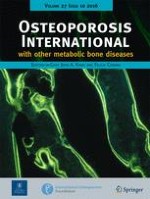01-10-2016 | Original Article
In vivo assessment of bone structure and estimated bone strength by first- and second-generation HR-pQCT
Published in: Osteoporosis International | Issue 10/2016
Login to get accessAbstract
Summary
Bone strength is dependent on bone density and microstructure. High-resolution peripheral quantitative computed tomography (HR-pQCT) can measure microstructure but is somewhat limited due to its resolution. We compared a new HR-pQCT scanner to existing technology and found very good agreement for most parameters. This study will be important when interpreting results from different devices.
Introduction
Recently, a second-generation HR-pQCT scanner (XCT2) has been developed with a higher nominal isotropic resolution (61 μm) compared to the first-generation device (XCT1, 82 μm). It is unclear how in vivo measurements from these two devices compare. In this study, we obtained and analyzed in vivo XCT1 and XCT2 measurements of bone microarchitecture and estimated strength.
Methods
We scanned 51 adults (16 men and 35 women, age 44.8 ± 16.0) on both XCT2 and XCT1 on the same day. We first compared XCT1 and XCT2 measurements obtained using their respective standard patient protocols. In XCT1, microarchitecture parameters were derived, while XCT2 measurements were directly measured. We also compared XCT2-D with XCT1 by finding the overlapping regions of interest and using the standard patient protocol for XCT1.
Results
We obtained excellent agreement between XCT1 and XCT2 for most of the volumetric bone mineral density (vBMD), trabecular and cortical measurements (All R
2 > 0.820) except for cortical porosity at the radius (R
2 = 0.638), trabecular number (R
2 = 0.694, 0.787) and trabecular thickness (R
2 = 0.569, 0.527) at both radius and tibia, respectively. XCT1 and XCT2-D measurements also had excellent agreement for most of the measurements (all R
2 > 0.870) except trabecular number (R
2 = 0.524, 0.706), trabecular thickness (R
2 = 0.758, 0.734) at both radius and tibia, respectively, and trabecular separation (R
2 = 0.656) at the radius.
Conclusion
While some caution should be exercised for parameters that are more dependent on image resolution, results from our study indicate that second-generation scans can be compared to more widely available first-generation data and may be beneficial for multicenter and longitudinal studies using both scanner generations.





